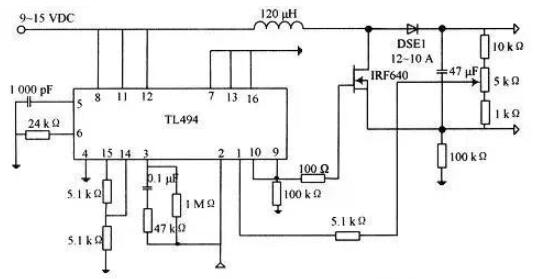
Privacy statement: Your privacy is very important to Us. Our company promises not to disclose your personal information to any external company with out your explicit permission.
Linear voltage regulator circuit has the advantages of simple structure, convenient adjustment, small output voltage pulsation, but the disadvantage is low efficiency, generally only 20% ~ 40%, and relatively bulky. Switching voltage regulator circuit can overcome the shortcomings of linear voltage regulator power supply, with high efficiency, generally can reach 65% ~ 90%, and small size, light weight, the grid voltage requirements are not high, so it is widely used in real life. Also because of the wide application of switching power supply, the corresponding professional students should be more profound and proficient in it, based on the design of pulse width modulation switching circuit (PWM), explain the debugging process of the system in detail.

First, system design principle
PWM type switching power supply transformer, rectifier, filter module processing is relatively simple, as long as the use of the corresponding transformer, single-phase full wave rectifier, capacitor filter can be realized, there is no need to introduce more space here. The core module of this system is the closed (negative feedback) module in the block diagram. If the Boost type DC-DC booster is directly used, it is simple to achieve, but the output/input voltage ratio is too large, the duty ratio is also large, and the output voltage range will become smaller, difficult to reach a higher index, and for open loop control. The special switching chip TL494 chip is used for this, which adopts switching pulse width modulation (PWM), has high efficiency, and the peripheral circuit is relatively simple, which can realize the closed-loop control conveniently.
1. Working principle of TL494
TL494 is a self-setting control circuit with a fixed frequency and applied pulse air conditioning system, where the oscillation frequency fosc=1.1/(RTCT). Specifically, due to the difference in the values of the input port 1,2 (or 3, or 4) of the error amplifier, there is a deviation, which is sent to the PWM comparator and the sawtooth wave (the frequency of sawtooth wave is determined by the oscillation frequency, the amplitude is fixed). When the deviation is greater than the sawtooth wave range, 9 (or 10) ports output low level; when the deviation is less than the sawtooth wave range, 9-port (or 10-port) output high level. The larger the deviation value is, the smaller the range of the TL494 output high level is. Thus, the duty ratio can be changed by adjusting the deviation of the input port of the error amplifier.
2. The working principle of boost converter
The output voltage of the boost converter can be controlled by controlling the on-off ratio of switch tube Q1. Its working principle is: set switch tube Q1 is controlled by signal VG, when VG is high power level, Q1 is switched on, on the contrary, Q1 is off. When Q1 is switched on, the voltage at both ends of the inductor VL=Vi, the inductive energy storage increases, and the load is powered by the capacitor. When Q1 is disconnected, the current on the inductor L cannot change, so the inductor current iL supplies power to the capacitor and load, and the energy stored on the inductor is transferred to the capacitor and load side. At this time, iL decreases and the induced electromotive force VL> on L; Zero, so Vo
Ii. Overall system design
The inverting end of the error amplifier 2 port input a given value (available MCU implementation, limited to length, do not introduce), used to control the output voltage; The feedback voltage of the input/output voltage of the port at the same phase end forms a closed-loop control. When the output voltage is higher than the expected value, the voltage of the feedback input port 1 increases, the output of the error amplifier increases, and the duty ratio decreases. When the output voltage is reduced, it can be basically equal to the expected value, so as to maintain the stability of the output voltage. To increase the output, you can increase the voltage of 2 ports. The control process is as follows: The original system is stable. When the voltage of 2 ports is increased, the voltage of 1 port is instantaneously unchanged, the output of the error amplifier decreases, the duty ratio increases, and the voltage increases. To reduce the output, reduce the voltage of the two ports.
Iii. System debugging
After the overall design is determined, the circuit debugging is carried out by the method of sub-module debugging.
1. TL494 performance test
Test the input voltage of port 2 (reference voltage input is adopted at port 2 of the reverse phase of the error amplifier), change the input voltage of port 1, and observe the output waveform of port 9 and port 3. The experimental results show that the reference voltage of TL494 is 3.5V; The output waveform is PWM wave; The error amplifier operates in the nonlinear region, and the PWM is only adjustable if the deviation of input ports (1,2) is between zero and tens of millivolts; Changing the voltage of 1 port can change the duty ratio of PWM.
2, boost converter performance test
Add square wave signal to port 1 to saturate the switch tube:
(1) Change the duty ratio and frequency of square wave signal;
(2) Add load to the output end.
According to the experiment, the output voltage can be changed by changing the duty ratio. With the load, the voltage is reduced, but by adjusting the duty ratio, the voltage can be increased; The larger the frequency of square wave signal, the smaller the range of adjusting output voltage by changing duty ratio.
3. Joint modulation
After the accurate information can be obtained in the above two steps, the two modules will be jointly adjusted. If correct, stable voltage output can be achieved at the output end, and the output voltage can be changed within a certain range (boost voltage) by changing the given value of the 2 ports. The specific range is related to the selected inductance, capacitance and frequency of the system operation. Due to space limitation, it will not be introduced here.
4. Add MOSFET(IRF640) driver
After the completion of the above circuit, the next to consider the system performance indicators, in addition to the above parameters of capacitance, inductance, operating frequency, superior performance indicators also related to MOSFET. For this purpose, a drive circuit IR2111 is added between the TL494 9-port and the IRF9540 switch tube.
According to the above steps to design the system, not only the circuit is simple, you can have a profound grasp of the TL494 working principle, the working principle of switching power supply, the working principle of negative feedback, and find the circuit error is also more convenient. For the performance index test of the circuit, due to the different parameters of the components, the index is slightly different, but basically the index of each parameter is high, for example, the efficiency of DC-DC converter can reach more than 85%.

September 10, 2024
Wyślij je do tym dostawcy
September 10, 2024
October 09, 2024

Privacy statement: Your privacy is very important to Us. Our company promises not to disclose your personal information to any external company with out your explicit permission.

Fill in more information so that we can get in touch with you faster
Privacy statement: Your privacy is very important to Us. Our company promises not to disclose your personal information to any external company with out your explicit permission.